Book contents
3 - Myth and prophecy: shared order
Published online by Cambridge University Press: 15 August 2009
Summary
INTRODUCTION
Sophoclean sentences, I suggested in chapter 1, can create trust in a world that exists beyond their words. Rather than pointing at themselves as some Gorgianic sentences do, they are unpredictable and therefore often appear to reflect the equally unpredictable world beyond them. In chapter 2 I looked at characters as one important part of this world. I argued that the language they use gives them the depth and elusiveness that is an attribute of real people, inviting spectators to share their perspective. In this chapter I will continue exploring how Sophoclean language evokes a world that seems almost palpably real although it goes beyond what can be seen and heard. Moving on from the characters (whose bodies and words, at least, are manifest on stage), I turn to entities which (like Cypris, phusis or the dead Oedipus of chapter 1) are entirely invisible and inaudible.
For this purpose I will continue to scrutinise individual sentences, as in chapter 1, and individual passages, as in chapter 2. But since part of my project is to suggest that Sophoclean language repays study on both a small and a large scale, in chapters 3 and 4 I will broaden the outlook further and trace certain invisible entities through whole plays.
- Type
- Chapter
- Information
- The Language of SophoclesCommunality, Communication and Involvement, pp. 92 - 132Publisher: Cambridge University PressPrint publication year: 1999

